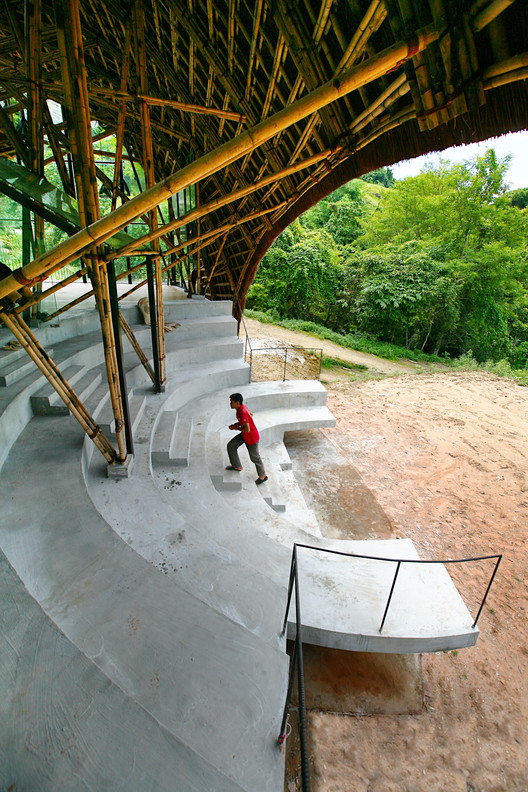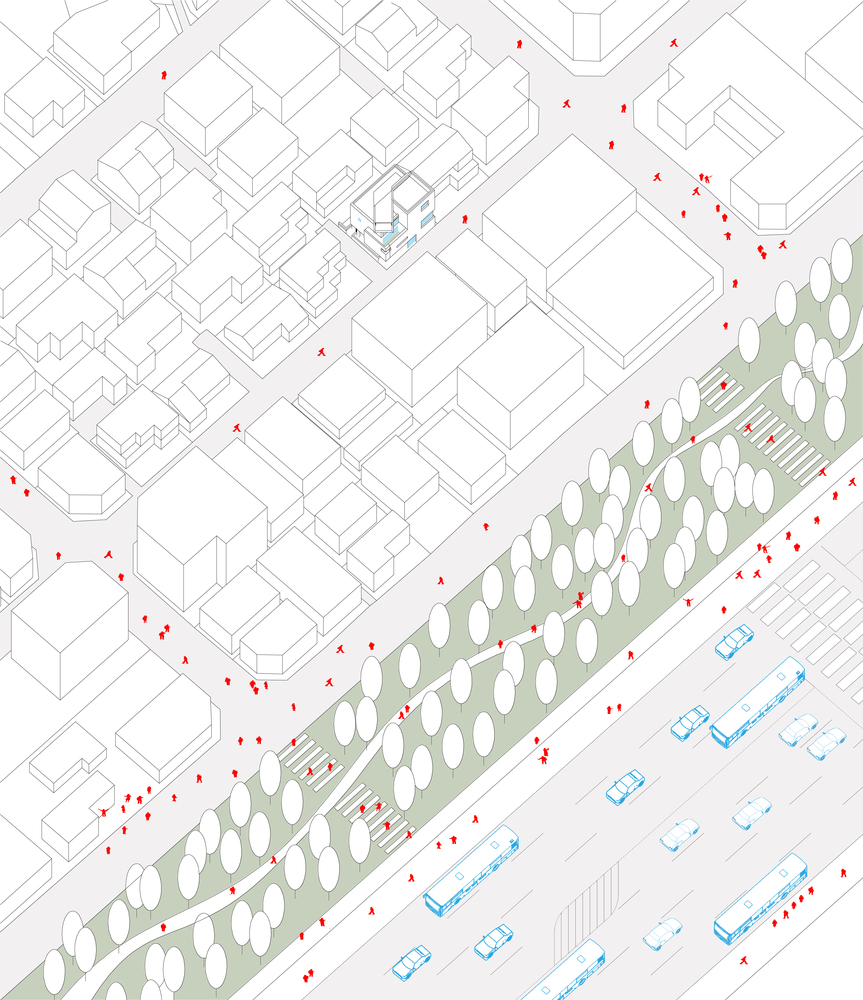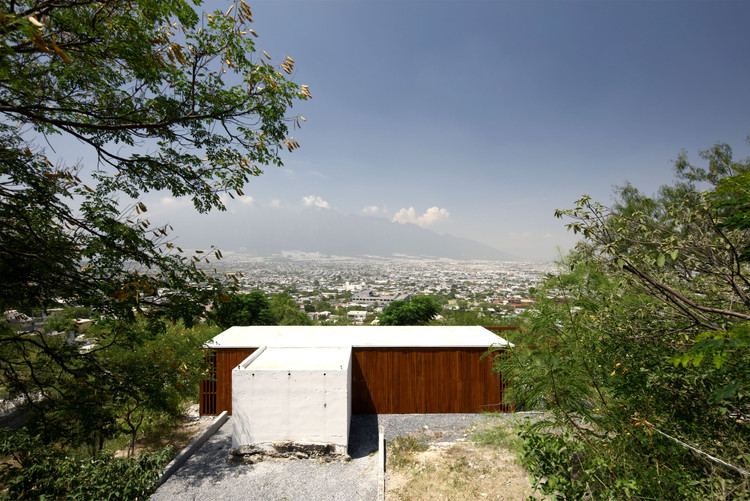Valley House Philip M Dingemanse
2015-04-15 18:00
© Luke Hesketh
卢克·赫斯凯特


架构师提供的文本描述。山谷房屋的形状和适应的轮廓向西北方向的山谷。俯瞰附近的城市和河流,房子的中心是这个山谷的前景。
Text description provided by the architects. The Valley House is shaped and adapted to the contours of a northwest-facing valley. Viewing down to the nearby city and river beyond, the house is centred on this valley outlook.
作为一个单一的连续物体上升到山谷边缘,主要的设计策略是集中在厨房,其中一个慷慨的开口是通过整个建筑物的深度。该建议是,山谷始终贯穿房屋,两边都有户外起居区,以适应多变的天气条件。
Formed as a singular continuous object rising to the valley edge, the principal design strategy is focused on the kitchen where a generous opening is made through the full depth of the building. The suggestion is that the valley remains continuous through the house with outdoor living areas on either side accommodating variable weather conditions.
© Luke Hesketh
卢克·赫斯凯特


建筑物的部分被拉开,形成保护翅膀,揭示了住宅的居住环境。塔斯马尼亚木材是一个特别关注的门槛之间的内外,而材料的纹理性质是进一步庆祝在内部。
Parts of the building are pulled away forming protective wings and reveal the inhabitation of the home. Tasmania timbers are a particular focus in the thresholds between inside and outside, while the textural qualities of materials are further celebrated in the interior.
© Luke Hesketh
卢克·赫斯凯特


在建造一个舒适的私人家庭住宅时,该计划力求以连贯一致的方式将功能要求的复杂性和微妙之处与特定地点和小气候条件相结合。
In crafting a comfortable and personal family home, the scheme seeks to blend the complexities and subtleties of functional requirements with specific site and microclimatic conditions in a cohesive and consistent manner.
作为一种独特的形式,建筑物的形状与谷地边缘在较低的一点,然后伸展与地点轮廓,高度上升到北部和东部。这座建筑暗示着通过树木向北低角冬日升起。
Conceived as a singular form, the building is shaped to meet the valley edge at a lower point and then stretched with the site contour, rising in height to the north and east. The building suggestively lifts up to the northern low angle winter sun through the trees.
© Luke Hesketh
卢克·赫斯凯特


黑暗的外墙上的元素被拉开,形成遮挡翅膀,外露的部分可见光,这是一个概念上的联系,允许太阳穿透建筑物。
The dark façade has elements pulled away to make shielding wings, with the exposed parts visually light, a conceptual connection to permitting the sun to penetrate the building.
覆盖的户外区域被创造出来,从黑暗的形态中减去空间,木材传递一种触觉和自然的温暖,用户在那里从内到外过渡。
Covered outdoor areas are created where space is subtracted from the dark form, with timber conveying a tactile and natural warmth where users transition from inside to outside.
Floor Plan


房子在山谷周围弯曲,在最高耸的部分沿着等高线弯曲,优化了山谷下面的生活区的重点,在那里,建筑物中有一个宽敞的开口。以厨房为中心,空间两侧的甲板服务于室内,而可操作的玻璃开口则在不可预测的小气候条件下进行调节。
The house is bent around the valley following the contour in the most elevated part of the site, optimising the focus of the living areas down the valley where a single generous opening is made in the building. Centred on the kitchen, decks on each side of the space serve the interior while operable glass openings mediate the unpredictable microclimatic conditions.
© Luke Hesketh
卢克·赫斯凯特


在外部,异形金属包层、水泥板和木材加强了与农村地区之间微妙的联系金属薄片的条纹使建筑形式统一起来。屋顶是为了响应主楼的方向和高度的变化而设计的,从上面的道路上可以看到第5层的高度,而东部的保护翼墙则遮住了附近的房子。
Externally, profiled metal cladding, cement sheet and timber reinforce a subtle link to the country shed typology in the rural context, yet elevate the modest material selections in their appropriation to residential architecture. The metal sheeting’s striation unifies the built form. The roof is articulated to respond to transitions in direction and height of the main building, becoming a significant 5th elevation viewed from the road above, while the eastern protective wing wall screens the neigbouring house above.
© Luke Hesketh
卢克·赫斯凯特


建筑物的结构框架是人工林用材,而局部来源的特色木材则有选择地使用。特征分级选择确保了各种变化的庆祝,并在可能的情况下,木材被取消涂层。塔斯马尼亚芹菜,顶部松木和黑木木材是当地来源和碾磨。
The buildings structural frame is plantation timber while locally sourced feature timbers are used selectively. The feature-graded selection ensures variations are celebrated and where possible timbers are uncoated. The Tasmanian celery top pine and blackwood timber is locally sourced and milled.
.jpg)

成本管理的辅助手段是在主入口处对建筑物进行半功能的战略弯曲。实际上,更多的预算分配给了生活地区,而更多的功利化地区则没有那么明确。浅平面图的深度和位置与等高线协助管理现场工作。
Cost management is assisted by the strategic bending of the building in half functionally at the main entry. Effectively more of the budget is allocated to the living areas while the more utilitarian areas are less highly specified. The shallow plan depth and siting with the contours assist with managing site works.
© Luke Hesketh
卢克·赫斯凯特


光伏发电是为了适应居民的使用管理输出到电网。高效的热泵技术有助于热水供暖和集中的存储单元和LED照明装置安装在整个。
Photovoltaic power generation is designed to suit the usage of the inhabitants with managed export to the power grid. Efficient heat pump technology contributes to hot water heating with a centrally located storage unit and LED lighting fixtures are installed throughout.
© Luke Hesketh
卢克·赫斯凯特


该建筑有一个179平方米的热控制室内面积,适当的太阳方向,一种形式,最大限度的自然照明和通风,有限的南方开口,和双层玻璃有助于在凉爽的温带气候区表现良好的信封。
The building has a thermally controlled indoor area of 179sqm while appropriate solar orientation, a form that maximises natural lighting and ventilation, limited southern openings, and double-glazing contribute to a well performing envelope in the cool temperate climate zone.
© Luke Hesketh
卢克·赫斯凯特




































.jpg)

.jpg)



Architects Philip M Dingemanse
Location Launceston, Australia
Category Houses
Area 267.0 sqm
Project Year 2014
Photographs Luke Hesketh
























